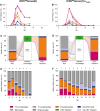Rational attenuation of canine distemper virus (CDV) to develop a morbillivirus animal model that mimics measles in humans
- PMID: 38415596
- PMCID: PMC10949419
- DOI: 10.1128/jvi.01850-23
Rational attenuation of canine distemper virus (CDV) to develop a morbillivirus animal model that mimics measles in humans
Abstract
Morbilliviruses are members of the family Paramyxoviridae and are known for their ability to cause systemic disease in a variety of mammalian hosts. The prototypic morbillivirus, measles virus (MeV), infects humans and still causes morbidity and mortality in unvaccinated children and young adults. Experimental infection studies in non-human primates have contributed to the understanding of measles pathogenesis. However, ethical restrictions call for the development of new animal models. Canine distemper virus (CDV) infects a wide range of animals, including ferrets, and its pathogenesis shares many features with measles. However, wild-type CDV infection is almost always lethal, while MeV infection is usually self-limiting. Here, we made five recombinant CDVs, predicted to be attenuated, and compared their pathogenesis to the non-attenuated recombinant CDV in a ferret model. Three viruses were insufficiently attenuated based on clinical signs, fatality, and systemic infection, while one virus was too attenuated. The last candidate virus caused a self-limiting infection associated with transient viremia and viral dissemination to all lymphoid tissues, was shed transiently from the upper respiratory tract, and did not result in acute neurological signs. Additionally, an in-depth phenotyping of the infected white blood cells showed lower infection percentages in all lymphocyte subsets when compared to the non-attenuated CDV. In conclusion, infection models using this candidate virus mimic measles and can be used to study pathogenesis-related questions and to test interventions for morbilliviruses in a natural host species.IMPORTANCEMorbilliviruses are transmitted via the respiratory route but cause systemic disease. The viruses use two cellular receptors to infect myeloid, lymphoid, and epithelial cells. Measles virus (MeV) remains an important cause of morbidity and mortality in humans, requiring animal models to study pathogenesis or intervention strategies. Experimental MeV infections in non-human primates are restricted by ethical and practical constraints, and animal morbillivirus infections in natural host species have been considered as alternatives. Inoculation of ferrets with wild-type canine distemper virus (CDV) has been used for this purpose, but in most cases, the virus overwhelms the immune system and causes highly lethal disease. Introduction of an additional transcription unit and an additional attenuating point mutation in the polymerase yielded a candidate virus that caused self-limiting disease with transient viremia and virus shedding. This rationally attenuated CDV strain can be used for experimental morbillivirus infections in ferrets that reflect measles in humans.
Keywords: attenuation; canine distemper; ferret; measles; model.
Conflict of interest statement
The authors declare no conflict of interest.
Figures






Similar articles
-
Infection of ferrets with wild type-based recombinant canine distemper virus overwhelms the immune system and causes fatal systemic disease.mSphere. 2023 Aug 24;8(4):e0008223. doi: 10.1128/msphere.00082-23. Epub 2023 Jun 28. mSphere. 2023. PMID: 37377421 Free PMC article.
-
Measles vaccination of nonhuman primates provides partial protection against infection with canine distemper virus.J Virol. 2014 Apr;88(8):4423-33. doi: 10.1128/JVI.03676-13. Epub 2014 Feb 5. J Virol. 2014. PMID: 24501402 Free PMC article.
-
Canine Distemper Virus Spread and Transmission to Naive Ferrets: Selective Pressure on Signaling Lymphocyte Activation Molecule-Dependent Entry.J Virol. 2018 Jul 17;92(15):e00669-18. doi: 10.1128/JVI.00669-18. Print 2018 Aug 1. J Virol. 2018. PMID: 29793948 Free PMC article.
-
Morbillivirus Experimental Animal Models: Measles Virus Pathogenesis Insights from Canine Distemper Virus.Viruses. 2016 Oct 11;8(10):274. doi: 10.3390/v8100274. Viruses. 2016. PMID: 27727184 Free PMC article. Review.
-
Canine and Phocine Distemper Viruses: Global Spread and Genetic Basis of Jumping Species Barriers.Viruses. 2019 Oct 14;11(10):944. doi: 10.3390/v11100944. Viruses. 2019. PMID: 31615092 Free PMC article. Review.
References
-
- Minta AA, Ferrari M, Antoni S, Portnoy A, Sbarra A, Lambert B, Hauryski S, Hatcher C, Nedelec Y, Datta D, Ho LL, Steulet C, Gacic-Dobo M, Rota PA, Mulders MN, Bose AS, Perea WA, O’Connor P. 2022. Progress toward regional measles elimination — worldwide, 2000–2021. MMWR Morb Mortal Wkly Rep 71:1489–1495. doi:10.15585/mmwr.mm7147a1 - DOI - PMC - PubMed
-
- Lemon K, de Vries RD, Mesman AW, McQuaid S, van Amerongen G, Yüksel S, Ludlow M, Rennick LJ, Kuiken T, Rima BK, Geijtenbeek TBH, Osterhaus ADME, Duprex WP, de Swart RL. 2011. Early target cells of measles virus after aerosol infection of non-human primates. PLoS Pathog 7:e1001263. doi:10.1371/journal.ppat.1001263 - DOI - PMC - PubMed
MeSH terms
Grants and funding
LinkOut - more resources
Full Text Sources
Medical
Miscellaneous

